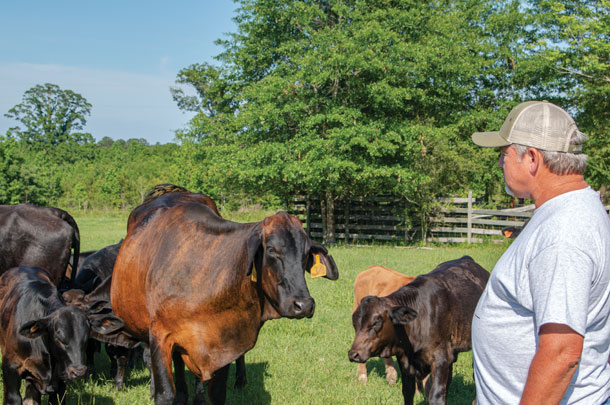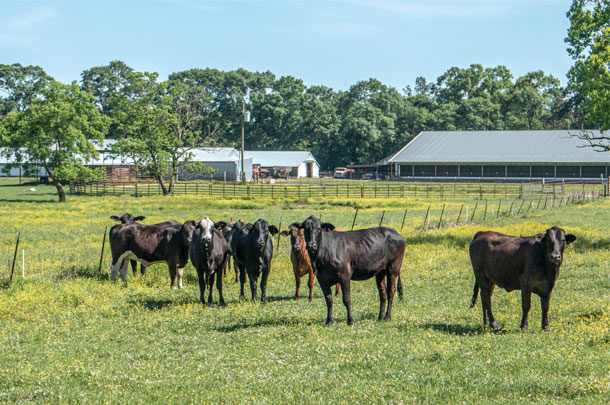And that’s why you’ll find him on a dozer clearing a 94-acre farm in Wayne County, Mississippi – or at least what once was farmland. About 10 years ago the family who owned the piece quit farming and let it go back to trees and brush. It is now so overgrown Pittman can’t drive a pickup across it. Pittman bought it to convert to pasture. “You can’t buy developed pasture and make it pay with cattle anymore,” Pittman says. “You have to find land you can develop and do the hard work of clearing and building the pastures.”
In Wayne County, developed pasture runs about $3,000 to $5,000 per acre. If it’s being sold for commercial or residential development, it’s much higher. “You can’t make that pay,” Pittman says. And a lot of land isn’t available at any price – it’s tied up in lifetime estates or is owned by timber companies. For that reason, he now has cattle stretched over 20 miles with owned and rented land.
The process of clearing land in Mississippi takes two to five years, Pittman says. “Sure, we’ll put cattle on it the first year we clear it, but there won’t be that much feed the first year. But with a little poultry litter and some clipping and clearing, the grass will come. It will choke out the invasives.” Clearing “scrap land” for pasture creates an acceptable profit margin for his 200-cow-calf- pair herd, when it’s combined with the poultry manure from his poultry houses.
Pittman first bought his uncle’s farm of 45 acres with four poultry houses. At the time, raising poultry was fairly profitable. Birds were brought in as day-old chicks. Within seven days, they’re seven times their original size. Birds ship out at 35 to 40 days old at 3.85 to 5-pound birds, all on contract with the integrator (a form of contract farming where the integrator hires farms to raise birds). One barn can hold 23,000 birds, and each barn has computer-controlled temperature sensors, water sensors and cooling and heating systems.
The integrator system leaves production control in the hands of the grower and was established as a way to improve cost efficiency for the poultry market and produce more uniform birds. The integrator owns the chicks, owns the feed, delivers the chicks and feed, and tells the grower when to load the trucks, supervising all phases of production. “So really, we’re just the facilities and labor. They’re the boss,” Pittman says. And in that system, “there’s little to no control of pricing or size.”
Pittman says it used to be that he had a new flock of birds within 14 to 16 days after the previous group left the barns, but now there are 28 to 30 days between groups, and growers have no control over that either. As a result, numbers of grow-outs decreased and profit margins shrank, as barn loans still came due with or without chicks growing in the poultry houses. Integrators began their own growing operations and over time have squeezed out some contract growers. And always hanging over the producer’s head is the fact that an integrator can pull the plug on a contract with a 90-day notice, or insist on a barn upgrade without long-term contract surety. “So you can get into trouble quickly if you’re not careful,” Pittman says.
With the downturn in poultry profits, Pittman decided he wanted to be the boss, to determine growth and success and determine markets. “And cows go hand in hand with chickens, because the poultry litter is like gold for pasture grass,” Pittman says. After land is cleared, he says, the fescue is about the only grass growing, but when he spreads poultry litter immediately the bahia, bermudagrass and clovers show up and quickly outgrow other scrubs and vegetation, making excellent pastures.
To boost pasture production, Pittman interseeds ryegrass on about 200 acres per year. “I take my tractor and load seed in the bucket, then pull the planter and a disc behind it,” he says. While some neighbors question his methodology, he says it works well for his pastures, and he sees a good return on the investment.
Although Pittman’s goal is to feed less hay and graze more grass, he currently gets three cuts of hay on a 52-acre field. The first cut of 100 to 125 bales is spring grass (a mixture of grasses and cover) and is fed to weaned heifers and calves. As summer heats up, the second and third cuts are mostly bahiagrass (150-225 bales from the second cutting, and the third cutting varies depending on weather). The 5x5 round bales are stored in a barn or on sloped, well-drained ground then covered with Visqueen plastic.
Pittman started his beef enterprise by shipping calves in the fall at 600 to 650 pounds, but grain costs rose and the profit margin decreased. To improve profits, he began using Angus and Sim-Angus bulls (on Brahman-X cows) from the top 25% of the genetics range in carcass quality. By breeding for bigger cattle, he could graze them through the winter on contracted grass through a custom grazier and send 800- to 850-pound cattle to feedlots in the spring when prices are stronger.
 Pittman also thought he could improve profits by sending cattle directly to feedlots in Kansas rather than selling through local auctions at weaning, “and people thought we were crazy,” he says. “They told me no one in Mississippi could send them to feedlots directly and make any money. They were wrong. The first year we tried it we actually doubled our money – hit a home run. The next year prices weren’t as strong but we still did much better than selling at weaning weights at the auction barn. If you raise cattle right, it works.”
Pittman also thought he could improve profits by sending cattle directly to feedlots in Kansas rather than selling through local auctions at weaning, “and people thought we were crazy,” he says. “They told me no one in Mississippi could send them to feedlots directly and make any money. They were wrong. The first year we tried it we actually doubled our money – hit a home run. The next year prices weren’t as strong but we still did much better than selling at weaning weights at the auction barn. If you raise cattle right, it works.”
White and red protein – “the two systems are made for each other,” Pittman says. “It’s been a learning curve, but I got some advice a long time ago, which was, ‘all that glitters is not gold’ and that advice has proved to be pretty valuable. You just have to find the profit margins and make those work for you.” ![]()
PHOTO 1: By spreading poultry litter on pastures, fescue has been replaced with bahiagrass, bermudagrass and clovers.
PHOTO 2: In Wayne County Mississippi, Brahman-X cows at S&B Farm are bred to bulls in the top 25% of the genetics range in carcass quality. Photos by Lynn Jaynes.

-
Lynn Jaynes
- Editor
- Progressive Dairy
- Email Lynn Jaynes










